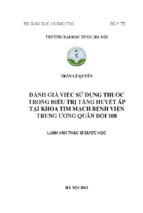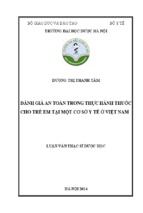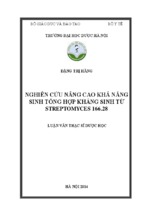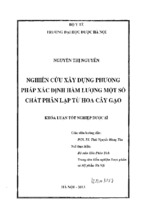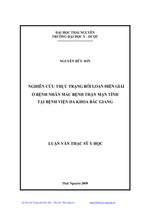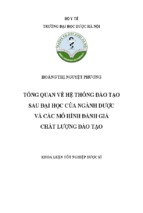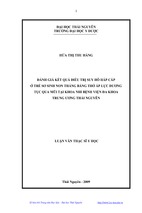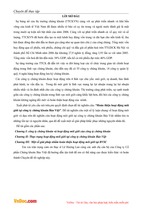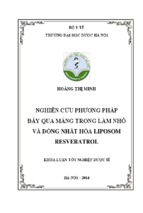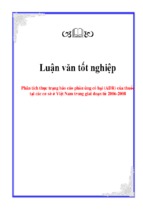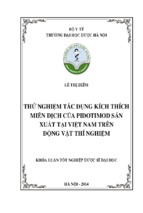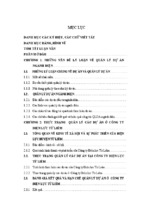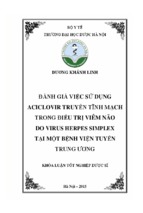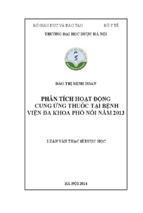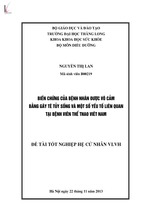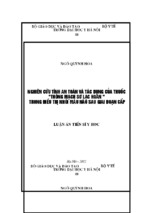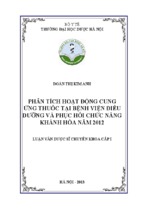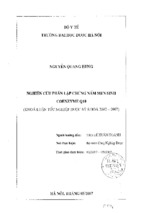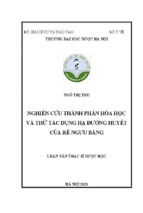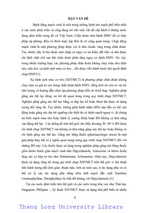A STUDY ON INCORPORATING CORPORATE SOCIAL RESPONSIBILITY
IN A TEA MANUFACTURING COMPANY: A CASE STUDY ON HUNG
CUONG TRADING LIMITED COMPANY
BY
DO XUAN TRUONG
Graduation Project Submitted to the Department of Business Studies, HELP
University College, in Partial Fulfillment of the Requirements for the Degree of
Bachelor of Business (Accounting) Hons
i
MARCH 2011
Declaration of Originality and Word Count
DECLARATION
I here by declare that this graduation project is based on my original work except for
quotations and citation which have been duly acknowledged. I also declare that it has
not been previously or concurrently submitted for any other courses/degrees at HELP
University College or other institutions. The word Count is 10,065 words.
DO XUAN TRUONG
28 March, 2011
ii
Acknowledgement
To accomplish this research, I have received help from many people. I extend my
sincere thanks to several people the following:
Firstly, I would like to deeply thank to my supervisor Dr. Le Van Lien, International
School. He helped me to develop the research and support me in analyzing the results.
Secondly, I also would like to express my thanks to Ms. Sumathi, Help University
College, who initiated the project and give me so much instruction and support.
Lastly, I would like to express my gratitude to managers and employees of Hung
Cuong Trading Limited Company.
DO XUAN TRUONG
iii
Abstract
A STUDY ON INCORPORATING CORPORATE SOCIAL RESPONSIBILITY
IN A TEA MANUFACTURING COMPANY: A CASE STUDY ON HUNG
CUONG TRADING LIMITED COMPANY
BY
DO XUAN TRUONG
March 2011
Supervisor: Le Van Lien
Corporate Social Responsibility (CSR) is a trend in the world today, but it is still
relative new in Vietnam. Companies want to compete, to grow, they need
to implement CSR. CSR is a competitive tool for them. The main aim of this research
is to find the level of awareness and the implementation of CSR of a tea company.
Researcher will use both of primary and secondary data to achieve this aim. In the
primary data, researcher uses questionnaire sample to collect data from managers and
employees of the company. After the analyzing of the results, researcher also gives
some recommendations for the company.
iv
TABLE OF CONTENT
Declaration of Originality and Word Count .............................................................ii
DECLARATION..........................................................................................................ii
Acknowledgement .......................................................................................................iii
Abstract ........................................................................................................................ iv
TABLE OF CONTENT............................................................................................... v
LIST OF FIGURRES AND TABLE .......................................................................viii
LIST OF ABBREVIATIONS .................................................................................... ix
CHAPTER 1: INTRODUCTION ............................................................................... 1
1.1 Research background ....................................................................................... 2
1.1.1 CSR in the world........................................................................................ 2
1.1.2 CSR in Viet Nam........................................................................................ 3
1.1.3 CSR in the tea industry ............................................................................. 4
1.2 Problem Statement ............................................................................................ 5
1.3 Objective and Sphere of Research ................................................................... 6
1.3.1 Objective of Research ................................................................................ 6
1.3.2 Sphere of Research .................................................................................... 6
1.4 Research methods .............................................................................................. 7
CHAPTER 2: LITERATURE REVIEW .................................................................. 8
2.1 Definition of CSR .............................................................................................. 9
2.2 Pyramid Concept of CSR ............................................................................... 11
2.3 The Concepts Related to CSR ........................................................................ 12
2.3.1 Stakeholder Theory ................................................................................. 12
2.3.2 Tripple Bottom Line ................................................................................ 13
2.3.3 Business Ethic .......................................................................................... 14
v
2.3.4 Sustainable Development ........................................................................ 14
2.3.5 Investment Decision ................................................................................. 15
2.3.6 Responsible Investment ........................................................................... 15
2.3.7 CSR Reporting ......................................................................................... 16
CHAPTER 3: RESEARCH METHODOLOGY .................................................... 17
3.1 Research Objective .......................................................................................... 18
3.2 Theoretical Framework and Measurement .................................................. 18
3.2.1 Managers .................................................................................................. 18
3.2.1.1 Level of Awareness .......................................................................... 18
3.2.1.2 Implementation ................................................................................ 19
3.2.2 Employees ................................................................................................. 19
3.2.2.1 Level of Awareness .......................................................................... 19
3.2.2.2 Implementation ................................................................................ 20
3.3 Research Methodology .................................................................................... 20
3.4 Data Source ...................................................................................................... 20
3.4.1 Primary Data............................................................................................ 20
3.4.2 Secondary Data ........................................................................................ 21
3.5 Research Method ............................................................................................. 21
3.6 Research tool .................................................................................................... 21
3.7 Sampling........................................................................................................... 22
3.7.1 Sample Population ................................................................................... 22
3.7.2 Sample Frame .......................................................................................... 22
3.7.3 Sample Size ............................................................................................... 22
3.8 Limitations ....................................................................................................... 22
3.9 Hypothesis Statement...................................................................................... 22
vi
CHAPTER 4: ANALYSIS ........................................................................................ 24
4.1 Collection of Questionnaires .......................................................................... 25
4.2 Description of Result ....................................................................................... 25
4.2.1 Age............................................................................................................. 25
4.2.2 Gender ...................................................................................................... 26
4.2.3 Managers .................................................................................................. 27
4.2.3.1 Level of Awareness .......................................................................... 27
4.2.3.2 CSR Implementation ....................................................................... 31
4.2.4 Employees ................................................................................................. 35
4.2.4.1 Level of Awareness .......................................................................... 35
4.2.4.2 CSR Implementation ....................................................................... 38
4.3 Result Analysis ................................................................................................ 42
4.3.1 Level of Awareness of CSR ..................................................................... 42
CHAPTER 5: CONCLUSION AND RECOMMENDATION .............................. 47
5.1 Conclusion ........................................................................................................ 48
5.2 Recommendation ............................................................................................. 49
5.3 Limitation of Study ......................................................................................... 50
5.4 Suggestion for Future Research ..................................................................... 50
REFERENCE (Harvard referencing system) ......................................................... 51
APPENDICES ............................................................................................................ 53
Appendix A: Questionnaire Sample .................................................................... 53
vii
LIST OF FIGURRES AND TABLE
Table 1: Elements and its items related to CSR ...................................................... 10
Figure 2.2: Pyramid model of CSR (Archie. B Carroll, 1979) ............................... 11
Figure 2.3: The relationship between firm and its stakeholders ........................... 13
Table 2: Age ................................................................................................................ 25
Table 3: Gender.......................................................................................................... 26
Table 4: Question 1 - Description of Result ............................................................. 27
Table 5: Question 2 - Description of Result ............................................................. 28
Table 6: Question 3 - Description of Result ............................................................. 29
Table 7: Question 4 - Description of Result ............................................................. 30
Table 8: Question 5 - Description of Result ............................................................. 31
Table 9: Question 6 - Description of Result ............................................................. 32
Table 10: Question 7 - Description of Result ........................................................... 33
Table 11: Question 8 - Description of Result ........................................................... 34
Table 12: Question 1 - Description of Result ........................................................... 35
Table 13: Question 2 - Description of Result ........................................................... 36
Table 14: Question 3 - Description of Result ........................................................... 37
Table 15: Question 4 - Description of Result ........................................................... 38
Table 16: Question 5 - Description of Result ........................................................... 39
Table 17: Question 6 - Description of Result ........................................................... 40
Table 18: Question 7 - Description of Result ........................................................... 41
viii
LIST OF ABBREVIATIONS
CSR
Corporate Social Responsibility
VND
Viet Nam Dong
TBL
Tripple Bottom Line
RI
Responsible Investment
SNV
Netherlands Development Organization
ADB
Asian Development Bank
CoC
Code of Conduct
ISO
International Organization for Standardization
OHSAS
Occupational Health & Safety Advisory Services
ix
x
CHAPTER 1: INTRODUCTION
1.1 Research background
1.1.1 CSR in the world
1.1.2 CSR in Viet Nam
1.1.3 CSR in the tea industry
1.2 Problem Statement
1.3 Objective and Sphere of Research
1.3.1 Objective of Research
1.3.2 Sphere of Research
1.4 Research methods
1
1.1 Research background
1.1.1 CSR in the world
Nowadays, Corporate Social Responsibilities is one of the hottest topics in the world.
CSR is the relationship between business and stakeholders. It affects directly on
reputation of businesses. Objectives of the business activity are not limited to profits.
Measure of business success is the impact that business creates for society. In
addition, long-term benefits of CSR are largely internal to the enterprise such as
improving relationships at work, reduce accidents, and reduce the rate of employee
severance, increased labor productivity. CSR will also help improve the reputation of
the business relationship with customers and partners, creating a competitive
advantage and facilitate the call for investment, especially foreign investment. CSR
focuses on society and the environment. The expectations of stakeholders are
economic benefits, environmental protection and social impact. The purpose of
businesses is that to meet expectations above to satisfy them. If they can do it, their
businesses will have a sustainable development. Sustainable development must
incorporate and harmony between the three aspects: economic development, social
development and environmental protection. Knowing this, multinational companies
have operations to towards the goal of sustainable development in many countries.
For example, some companies in automotive industry (Volvo); garment (Nike,
Addidas) and dairy industry (Friesland foods)… have CSR report annually. They
produce high quality product, sponsor for many programs that related to children or
construct wastewater treatment systems to protect environment. On the other hand,
some companies are still not aware of the importance of CSR; they have caused
damage to the environment, clients and themselves (effect on their reputation). For
instance, BP is one of the biggest oil companies in the world. However, BP has
2
encountered a problem that is serious oil spill in the Gulf of Mexico. The cause of this
incident is due to the lack of supervision, poor safety... Living environment is
threatened seriously have caused more sickness, poverty for the people. In addition,
marine organisms can not survive, caused ecological imbalance.
1.1.2 CSR in Viet Nam
In fact, CSR is still a new field in Vietnam, but particularly important
for the sustainable development of enterprises. Restriction to implement CSR in
Vietnam may be due to the perception of business about CSR, or because limited
financial and technical to implement CSR...In Vietnam, success in accelerating
economic growth is putting the country on environmental issues and pressing social.
The main issues that are demanding the economic entities, including businesses,
should have the responsibility to contribute to reduce problems or make better.
Enterprises are only interested with profits while the environment and society face
with damages caused by them. To reduce this problem, government has some
activities to encourage businesses such as CSR awards, organize seminars on CSR
and sustainable development to increase the level of awareness about CSR of
businesses. Evidence that, from 2005, Chamber of Commerce and Industry of
Vietnam, Ministry of Labour, Invalids and Social Affairs, Ministry of Trade and
Industry along with Association Footwear, Textiles awarded “the Corporate Social
Responsibility towards sustainable development” to honor the small business which
implemented social responsibility in the context of enterprise integration. Currently,
many large enterprises in Vietnam have found that social responsibility of enterprises
has become one of the indispensable requirements for enterprises, because, in the
context of globalization and international integration, if the business does not comply
with social responsibilities, they will not be able to gain access to world markets.
3
Many businesses when implementing social responsibility has brought practical
results in the production. Results of a recent survey by the Institute of Labor Studies
that conducted over 24 social enterprises of the two industries (Shoes and Textiles)
showed that: by the implementation of social responsibility programs, turnover of
business has increased 25%, labor productivity has increased from 34.2 million VND
to 35.8 million VND per worker per year and the ratio of exports increased from 94%
to 97%. Besides economic efficiency, these enterprises want to strengthen its
reputation with customers, create the closeness and satisfaction of employees for
enterprises, and attract labor force with highly specialized (Duc. P V, 2010).
1.1.3 CSR in the tea industry
As we know, tea production and processing are closely related to many issues such as
social, workers, ecology ... In the past, when looking at labor, social, ecology, we see
only violation of international standards in the tea industry. To solve these problems,
a number of initiatives have been introduced. Firstly, Unilever launched an initiative
for sustainable tea, it means that create sustainable agriculture initiatives for tea. For
example, Unilever will collaborate with the Ministry of Agriculture and Rural
Development to help the tea growers in Vietnam to build tea farms for sustainable
development and increase exports of "green and clean" tea. Secondly, according to the
Dutch tea initiative, this civil society initiative calls upon companies selling tea in the
global market to assume their responsibility for sustainable production and trade.
Companies focused improving human resources, quality products and services to
consumers. Simultaneously they have interested to community issues, and reduce
environmental degradation (Sandun, 2010). In addition, they have given the Code of
Conduct (CoC) of tea industry to increase the awareness and understanding of CSR
for all tea companies. From all initiatives above, we can see that, CSR issues in the
4
tea industry is being interested and conducted by concerned parties, doing this to
create a good picture of the tea industry, issues such as hygiene and food safety,
consumer interests, health and safety of workers, environmental concerns are the top
interested of tea enterprises.
1.2 Problem Statement
In recent years, companies in Vietnam have caused serious impacts on the
environment while environmental protection is an aspect of CSR. For example, Vedan
discharges untreated waste into the environment, affecting nearly 2.700ha farming
area along the Thi Vai River basin. Level of pollution was 90% with the range of
about 10km affected along the river (Dantri, 2009). Another example is that a Taiwan
company, namely Tung kuang, was caught because it discharging untreated waste
water directly into the environment, concentrations of hazardous substances
exceeding specified thresholds. These are two typical examples of serious violations
to the environment, as well as a lack of understanding, poor awareness about the harm
caused by environmental pollution. The enterprises need to put CSR into their
strategies. Vinamilk is an example; they have some programs related to CSR such as
“milk fund”. The biggest success of this fund is to ensure that drinking milk per day is
right of poor children of Vietnam to they have developed a comprehensive physical
and spiritual (Vuoncaovietnam, 2010). This action will also improve the image
and reputation of the company, many Vietnamese people buy Vinamilk’s products
because they know that Vinamilk has interested to their children. From all cases
above, we can see that the important of CSR for both company and stakeholders. CSR
will help to increase the reputation of the company, to bring more profit for
shareholders, to ensure the fresh environment for society and so on. Do be aware of
the importance and benefits of implementing social responsibility in the context of
5
globalization and international integration, a number of large enterprises in Vietnam
has made social responsibility in the form of commitment to society in protecting the
environment, local communities and the workers. In the tea industry, although no
action was striking about CSR, but the companies had many attempts to meet the
maximum requirements of customers, employees, communities and society.
1.3 Objective and Sphere of Research
1.3.1 Objective of Research
In order to do this research, there are some main objectives of research:
- The first objective is to provide a framework about CSR, including the definition,
concepts related to CSR.
- The second objective is to find the level of awareness of CSR in a tea manufacturing
company (Hung Cuong).
- The third objective is to present the benefits that CSR can bring to company and
stakeholders.
- The next objective is to show the implementation of CSR of the tea company.
- The last objective is to recommend a CSR framework for the company.
1.3.2 Sphere of Research
In this research, the researcher examines the level of awareness and implementation
of CSR of managers and employees in Hung Cuong Company. Hung Cuong trading
limited company is one of top tea exporting company in Vietnam. Hung Cuong was
established in 1998. Headquarter is an area of two hectares in Ha Giang
province. Company has five plants and a warehouse which are located in Ha Giang
province for the production. Branch is in charge of market development, businessoriented and sales in Hanoi. Warehouse is used to store tea products and prior
packaging to shipment in Hung Yen province. Hung Cuong has 500 employees and
6
1500 farmers. Leadership of the company including CEO and vice presidents, they are
the ones who graduated from the University of National Economics, Foreign Trade
University and has years of experience in working and managing. In addition,
company also regularly organizes training courses and training for staff and workers
who directly produce or those responsible for production technology. In recent years,
Hung Cuong Trading Co., Ltd has a special emphasis on quality, food hygiene and
safety, the environment, looking for export markets, customer choice, and expand
plant processing, always create regular jobs for hundreds of workers, tea growers.
Along with the development of the tea industry in general, Hung Cuong has tried its
best, put the company growing. By doing this, Hung Cuong has received several
environmental awards from the government (vea, 2010).
1.4 Research methods
In order to do this research, the researcher is used survey method to collect
information from managers and employees. The researcher send questionnaire to
managers and employees of Hung Cuong trading limited company. Because Hung
Cuong has many employees, researcher can collect result easily. After that, researcher
was use the Microsoft Excel to analyze and checks the result collected.
7
CHAPTER 2: LITERATURE REVIEW
2.1 Definition of CSR
2.2 Pyramid Concept of CSR
2.3 The Concepts Related to CSR
2.3.1 Stakeholder Theory
2.3.2 Tripple Bottom Line
2.3.3 Business Ethic
2.3.4 Sustainable Development
2.3.5 Investment Decision
2.3.6 Responsible Investment
2.3.7 CSR Reporting
8
2.1 Definition of CSR
CSR is one of the most concerned issues today; there are many definitions of CSR in
the world. From 50 years ago, H.R. Bowen published his book entitled "Social
Responsibility of Businessmen" with propaganda purposes and called the property
managers do not harm the rights and interests of others, calling charity to compensate
for damage caused by the enterprise for social harm. However, since then, the term
social responsibilities of enterprises are being interpreted in different ways. Some
people define "social responsibility implies improving the behavior of enterprises to a
level consistent with the norms, values and social expectations are common"
(Prakash, Sethi, 1975). Some people understand "social responsibility of enterprises,
including the expectations of society on economic, legal, ethical and charity
organizations for a certain time" (Archie. B Carroll, 1979), or the definition comes
from Business for Social Responsibility: “CSR is defined as operating a business in a
manner that meets or exceeds the ethical, legal, commercial and public expectations
that society has of business. CSR is seen by leadership companies as more than a
collection of discrete practices or occasional gestures, or initiatives motivated by
marketing, public relations or other business benefits. Rather, it is viewed as a
comprehensive set of policies, practices and programs that are integrated throughout
business operations, and decision-making processes that are supported and rewarded
by top management”. Lord Holme and Richard Watts said that “Corporate Social
Responsibility is the continuing commitment by business to behave ethically and
contribute to economic development while improving the quality of life of the
workforce and their families as well as of the local community and society at large”.
From all definitions above, we know that businesses want to sustainable development,
they must always abide by the standards of environmental protection, gender equality,
9
labor safety, labor rights, fair pay, training and staff development and development
community. Corporate social responsibility is expressed specifically on the elements,
such as market, environment, employee, local community. The table 1 below shows
some items that businesses need to do when they do CSR:
Market
Environment
Employee
Local
community
- Product quality
- Climate protection
- Compatibility of
- Company
- Product
- Consumption of
family & occupation
donations
information
resources
- Advanced training
- Sponsoring
- Consumer
- Renewable
&
- Awarding of
protection
energies
qualification
contracts
- Excluded
- Environmental
- Equal opportunities
to social
customer
effects
&
organizations
segments
on the location
diversity
- Charities
- Suppliers &
- Environmental
- Job security
- Voluntary
purchasing
awareness of the
- Employee
commitment
- Fair dealings with employees
contribution
of employees
business partners
- ...
- Environmental
Management
Table 1: Elements and its items related to CSR
With specific content of social responsibility above, the implementation of social
responsibility of enterprises not only makes business sustainable development, but
also contributes to the sustainable development of society in general.
10
- Xem thêm -

